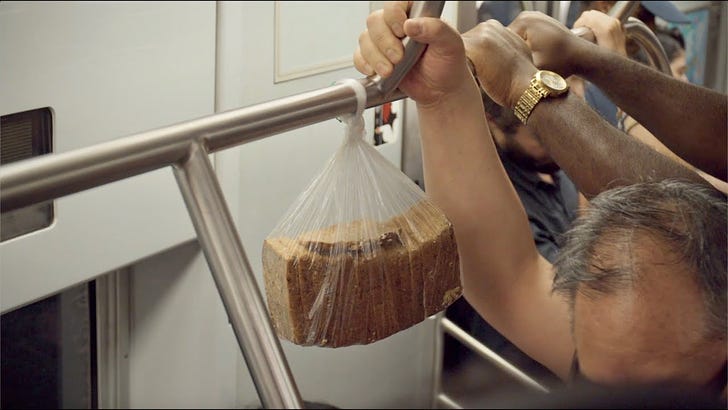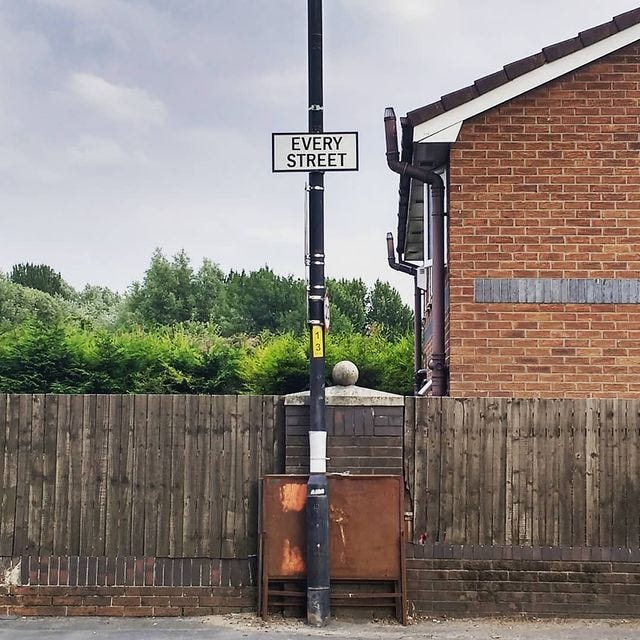So far this newsletter has mostly covered political aspects of comedy, which is OK, but my general idea is finding the funny in things is more than a means to an end. As you’ll see, every now and then I get into the more abstract qualities of humour, and how some believe it is more like a holistic practice of the everyday. This is one of those times.
Look, I got a lot of work to do, so all three of this week’s links come from my own Instagram page. I promise they do help you get in the mood for the main event below though.
Did you also read “paralegal pianos”? Might be because the shop next door is called “criminal records”.
Pharaoh on one side, (glass pyramid) on the other.
A picture of every street in Manchester.
Friends who know about my Instagram account told me I needed to watch this new HBO show called How To with John Wilson, so I did. It’s great.
The series follows (or, more accurately, precedes) director John Wilson as he roams about the streets of New York and other American locations, filming everything he sees. Every episode is an artfully assembled sequence of short clips, details captured in random moments and displayed from his point of view. Wilson’s voice-over narrates the development of a different, small quest every time (hence the “how to” premise) that invariably guides him towards increasingly unexpected encounters. Looking for ways to cover furniture may lead to talking with foreskin enthusiasts, investigating how to properly split a check takes him to an obscure referee-only dinner that ends in theft. This snowballing dynamic is one of a few things the show has in common with Nathan For You (the second being Nathan Fielder himself, who is a producer), but the serendipitous and poetic tone of How To puts it in a different league.
The clip above illustrates just the type of nuggets Wilson decides to showcase: things that are only funny is a small, specific, ineffable type of way, the kind of “glitches in the matrix” that only someone with a trained eye like him (he has apparently worked for a private investigator in the past) might be able to catch.
Wilson’s former occupation reminds me of Julius Knipl, a character created by Ben Katchor (a quintessential New Yorker and quintessentially Jewish cartoonist). Sharing a very similar focus on everyday marginalia, Knipl is a “real-estate photographer” who often acts as a mere Waldo in Katchor’s strips, a narrative conduit existing only to witness hyper-specific hues of the human spectrum (in the strip above, for example, we learn about the obscure routine of electric sign watchers). Beyond the centrality of New York as an infinite prism of lived life, the Mecca of observational comedy (Seinfeld is here too canonical not to mention it), the refraction of its urban elements is another common element How To has with Katchor’s strips. Appropriately, Wilson dedicates in fact an entire episode to the city’s ubiquitous scaffoldings: a makeshift infrastructure of impermanence that, paradoxically, never disappears, congealing instead into an allegory of the city’s ever-flowing nature.
The show inspires comparisons beyond comedy, however. Wilson’s fascination with a plastic bag full of bread, loosely tied to a handrail on an NYC subway coach, easily reminds of the iconic plastic bag scene in American Beauty; and there is definitely something existential and mystical about his meanderings, as well as a semi-desperate need for meaning, extracted from constellations of unrelated phenomena. Not unlike a wandering user of the Randonautica app (“the world's first quantumly generated Choose Your Own Adventure reality game”), the director lets the world take him by surprise, but does not renounce overwriting his own thoughts and schemas on top of the signals he receives.
The poetic nature of How To lies in part in our suspension of incredulity: what we see is unique, and it really happened, but the artful narration that mesmerises us is of Wilson’s doing. The clip above (which is not from How To, but an earlier Vimeo incarnation) chronicles the director’s trip to a Vegas wholesale fair, where he talks about God and spirituality with a range of vendors (most of whom sell sex gadgets). There is a melancholia to the trip, and definitely the eternal impermanence embodied by the New York scaffoldings is here, too: not unlike in Knipl’s strips, we witness obsolete objects and soon-to-be-obsolete jobs, about to be swept away by relentless economic development. In a very short clip, Wilson toys with a Marx colouring book at a Trump hotel; in another, a mannequin Steven Spielberg makes him wonder if future films will be shot by robots.
But melancholia does not necessarily defeat comedy. Wilson’s work does not always aim at making you laugh out loud (although it definitely does at times) and it is definitely hard to pin down as “comedic”. Under the changing skylines of Vegas and NYC, between scaffoldings, trash bags, and anti-homeless spikes, Wilson takes us on a weird trip whose value may not be the proverbial “friends we made along the way”, but rather - if anything - the feeling that, if we keep looking, something will happen.









